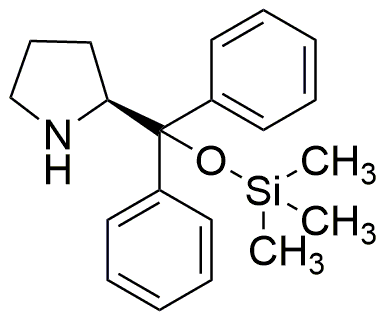(S)-(-)-a,a-Diphenyl-2-pyrrolidinemethanol Trimethylsilyl Ether is widely utilized in research focused on:
- Synthetic Organic Chemistry: This compound serves as a versatile building block in the synthesis of complex organic molecules, enabling researchers to explore new chemical pathways and develop innovative products.
- Pharmaceutical Development: It is used in the formulation of pharmaceutical compounds, particularly in the design of drugs that target specific biological pathways, enhancing efficacy and reducing side effects.
- Material Science: The compound finds applications in creating advanced materials, such as polymers and coatings, which benefit from its unique chemical properties, improving durability and performance.
- Analytical Chemistry: It acts as a reagent in various analytical techniques, aiding in the identification and quantification of other chemical substances, thus streamlining research processes.
- Biotechnology: The compound is leveraged in bioconjugation strategies, facilitating the attachment of biomolecules to surfaces or other molecules, which is crucial for developing biosensors and targeted drug delivery systems.
General Information
Properties
Safety and Regulations
Applications
(S)-(-)-a,a-Diphenyl-2-pyrrolidinemethanol Trimethylsilyl Ether is widely utilized in research focused on:
- Synthetic Organic Chemistry: This compound serves as a versatile building block in the synthesis of complex organic molecules, enabling researchers to explore new chemical pathways and develop innovative products.
- Pharmaceutical Development: It is used in the formulation of pharmaceutical compounds, particularly in the design of drugs that target specific biological pathways, enhancing efficacy and reducing side effects.
- Material Science: The compound finds applications in creating advanced materials, such as polymers and coatings, which benefit from its unique chemical properties, improving durability and performance.
- Analytical Chemistry: It acts as a reagent in various analytical techniques, aiding in the identification and quantification of other chemical substances, thus streamlining research processes.
- Biotechnology: The compound is leveraged in bioconjugation strategies, facilitating the attachment of biomolecules to surfaces or other molecules, which is crucial for developing biosensors and targeted drug delivery systems.
Documents
Safety Data Sheets (SDS)
The SDS provides comprehensive safety information on handling, storage, and disposal of the product.
Product Specification (PS)
The PS provides a comprehensive breakdown of the product’s properties, including chemical composition, physical state, purity, and storage requirements. It also details acceptable quality ranges and the product's intended applications.
Certificates of Analysis (COA)
Search for Certificates of Analysis (COA) by entering the products Lot Number. Lot and Batch Numbers can be found on a product’s label following the words ‘Lot’ or ‘Batch’.
*Catalog Number
*Lot Number
Certificates Of Origin (COO)
This COO confirms the country where the product was manufactured, and also details the materials and components used in it and whether it is derived from natural, synthetic, or other specific sources. This certificate may be required for customs, trade, and regulatory compliance.
*Catalog Number
*Lot Number
Safety Data Sheets (SDS)
The SDS provides comprehensive safety information on handling, storage, and disposal of the product.
DownloadProduct Specification (PS)
The PS provides a comprehensive breakdown of the product’s properties, including chemical composition, physical state, purity, and storage requirements. It also details acceptable quality ranges and the product's intended applications.
DownloadCertificates of Analysis (COA)
Search for Certificates of Analysis (COA) by entering the products Lot Number. Lot and Batch Numbers can be found on a product’s label following the words ‘Lot’ or ‘Batch’.
*Catalog Number
*Lot Number
Certificates Of Origin (COO)
This COO confirms the country where the product was manufactured, and also details the materials and components used in it and whether it is derived from natural, synthetic, or other specific sources. This certificate may be required for customs, trade, and regulatory compliance.


